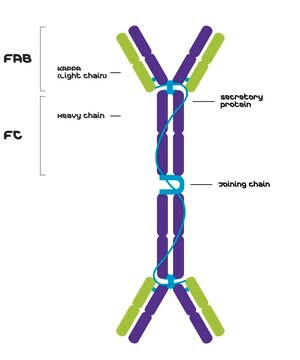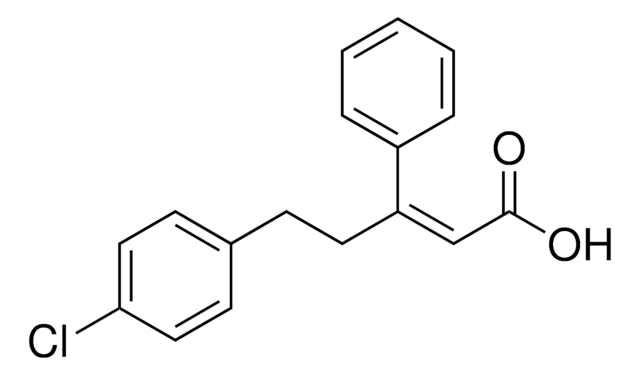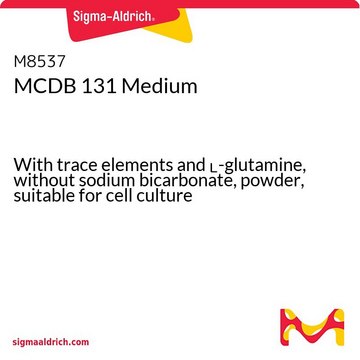M3769
Medium 199
Modified, with Earle′s salts, without L-glutamine, sodium bicarbonate, and phenol red, powder, suitable for cell culture
Sinônimo(s):
M199 Medium, TCM 199
Faça loginpara ver os preços organizacionais e de contrato
About This Item
Código UNSPSC:
12352207
NACRES:
NA.71
Produtos recomendados
Nível de qualidade
Formulário
powder
técnica(s)
cell culture | mammalian: suitable
componentes
L-glutamine: no
phenol red: no
HEPES: no
sodium pyruvate: no
Earle’s salts (5% CO2): yes
NaHCO3: no
Condições de expedição
ambient
temperatura de armazenamento
2-8°C
Procurando produtos similares? Visita Guia de comparação de produtos
Descrição geral
Medium 199 is a combination of vitamins, amino acids, and other factors that were originally developed as a completely defined media formulation for the culture of primary explants. This medium, when properly supplemented has broad applicability, particularly for non-transformed cells. Medium 199 is widely used for vaccine production, in vitro cultivation of primary pancreatic explants, and lens tissues.
Aplicação
Medium 199 has been used:
- to culture the primary human umbilical vein endothelial cells (HUVECs) for use in cell viability assay
- to flush the uterine horn of gilts to recover day 12 conceptuses from uteri
- to culture the peritoneal cells and immortalized human mesothelial cells (MeT-5A and ATCC-CRL-9444)
Quantidade
Formulated to contain 9.4 grams of powder per liter of medium.
Reconstituição
Supplement with 0.1 g/L L-glutamine, 2.2 g/L sodium bicarbonate.
geralmente comprado junto com este produto
Nº do produto
Descrição
Preços
Código de classe de armazenamento
13 - Non Combustible Solids
Classe de risco de água (WGK)
WGK 1
Ponto de fulgor (°F)
Not applicable
Ponto de fulgor (°C)
Not applicable
Escolha uma das versões mais recentes:
Já possui este produto?
Encontre a documentação dos produtos que você adquiriu recentemente na biblioteca de documentos.
Os clientes também visualizaram
Agnieszka Blitek et al.
Theriogenology, 127, 88-101 (2019-01-25)
Peroxisome proliferator-activated receptors (PPARs) are members of the nuclear receptor family of ligand-dependent transcription factors. PPARs are important regulators of glucose and fatty acid metabolism, apoptosis, angiogenesis, cell proliferation and differentiation, and immune response. Their possible role in the female
Diane G Edmondson et al.
mBio, 12(1) (2021-02-25)
The bacterium that causes syphilis, Treponema pallidum subsp. pallidum, has now been cultured in vitro continuously for periods exceeding 3 years using a system consisting of coculture with Sf1Ep rabbit epithelial cells in TpCM-2 medium and a low-oxygen environment. In
Kenneth W Olsen et al.
Molecular vision, 17, 270-278 (2011-02-02)
The crystalline lens is a unique cellular organ that performs metabolic processes while maintaining transparency for optical functionality. Mitochondria play a role in providing cells with aerobic respiration necessary for these metabolic processes. Using menadione, a mitochondria-specific inhibitor of the
Klaus Kratochwill et al.
Nephrology, dialysis, transplantation : official publication of the European Dialysis and Transplant Association - European Renal Association, 27(3), 937-946 (2011-08-23)
Exposure of mesothelial cells to peritoneal dialysis fluids (PDF) results in cytoprotective cellular stress responses (CSR) that counteract PDF-induced damage. In this study, we tested the hypothesis that the CSR may be inadequate in relevant models of peritoneal dialysis (PD)
Martina Maccesi et al.
Parasites & vectors, 12(1), 493-493 (2019-10-24)
Over the past five years, as a public service to encourage and accelerate drug discovery for diseases of poverty, the Medicines for Malaria Venture (MMV) has released box sets of 400 compounds named the Malaria, Pathogen and Stasis Boxes. Here
Nossa equipe de cientistas tem experiência em todas as áreas de pesquisa, incluindo Life Sciences, ciência de materiais, síntese química, cromatografia, química analítica e muitas outras.
Entre em contato com a assistência técnica








